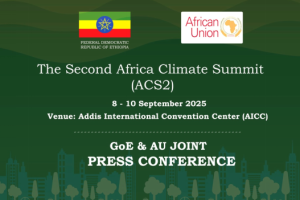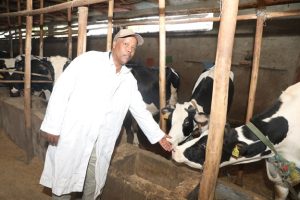BY EPHREM ANDARAGCHEW
The Horn of Africa has frequently experienced recurrent droughts and drought challenges seriously the region. The negative effect of climate change and consecutive poor rainfall seasons have been the causes of low crop production, rising cereal prices, poor rangeland conditions, reduced livestock production, and drought-related animal deaths in many parts of the region.
According to the UN Department of Economic and Social Affairs Sustainable Development, Ethiopia, home to 120 million people, is one of the world’s most drought-prone countries and has a high degree of vulnerability to hydro-meteorological hazards and natural disasters. Dependence on sectors that are climate change sensitive such as rain-fed agriculture, water, tourism, and forestry as well as a high level of poverty are the main factors that exacerbate Ethiopia’s vulnerability.
Taking the impact of climate change into account, Ethiopia launched the Green Legacy Initiative in June 2019. The initiative has set a target of planting 20 billion seedlings within a period of four years. However, by the fourth year, Ethiopia has achieved planting 25 billion seedlings by mobilizing all citizens throughout the nation.
Apart from combating climate change, the green legacy initiative helps Ethiopia to develop more than 120,000 nurseries throughout the country which create more than 767,000 jobs, mostly for women and youth. It is also a demonstration of Ethiopia’s long-term commitment to a multifaceted response to the impacts of climate change and environmental degradation that encompasses agroforestry, forest sector development, greening and renewal of urban areas, and integrated water and soil resources management.
Besides, the Initiative has an immense contribution to Ethiopia’s efforts to meet its international commitments such as the Paris Climate Change Agreement, the 2030 Agenda for Sustainable Development, and Agenda 2063: The Africa We Want.
Hence, due to the importance of the Initiative, the United Nations Development Program (UNDP) wants to share Ethiopia’s Green Legacy Initiative with 10 African Countries. The UNDP shares the experiences of the Initiative to make the Initiative Pan-African.
A high-level UN sideline event has been held in New York to discuss Ethiopia’s Green Legacy Initiative and its role in battling climate change and easing the socio-economic crisis. The event was organized by the Government of Ethiopia in partnership with UNDP and the AU-Mission to the UN.
During the occasion, Deputy Prime Minister and Foreign Minister, Demeke Mekonnen explained that the Green Legacy initiative in Ethiopia strengthens regional cooperation and will ultimately serve as a crucial platform to ensure peace and stability in Ethiopia and the Horn of Africa.
Ethiopia provided high-quality seedlings of preference to some of its neighbors last year and plans to do the same in the years to come in an effort to promote regional cooperation and combat the negative effects of climate change, he added.
Demeke praised the initiative, which is led by Prime Minister Abiy Ahmed, thanked UNDP for its partnership with Ethiopia, and called on support for the Initiative from bilateral and multilateral development partners.
Supporting the Green Legacy Initiative has an enormous advantage for national, regional, and international adaptation and mitigation of the harmful effects of climate change, biodiversity preservation, combating desertification, ensuring green development, ensuring food security, and achieving the SDGs, according to Demeke.
Alhaji Fall, speaking on behalf of Ahunna Eziakonwa, Assistant Administrator and Regional Director for Africa at the UNDP, described the Green Legacy initiative as a stepping stone to a better future for Ethiopia. Announcing UNDP’s plan to share Ethiopia’s experiences with about 10 other countries and make the Initiative Pan- African, he praised Ethiopia for setting the pace in combating climate change and for fostering community resilience.
A technical committee coordinator for the Initiative Dr. Adefres Worku tabled a presentation outlining the initiative’s three years of experience and potential benefits at the continental level. Overall, the innovative aspect of the Initiative lies in its potential to address multiple objectives.
This entails enormous benefits in environmental protection, restoration of overexploited and degraded natural resources such as surface soil and water, halting desertification, and many other interrelated objectives. The enormity of the interlinkages will significantly contribute to Ethiopia’s efforts to achieve the Sustainable Development Goals by 2030. Therefore, sharing the experiences of the Initiative and its achievement is a stepping stone not only for Ethiopia but also for a better future for Africa.
THE ETHIOPIAN HERALD WEDNESDAY 28 SEPTEMBER 2022




